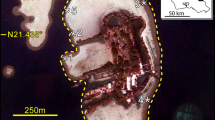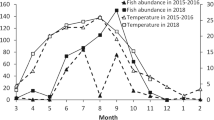Abstract
The occurrence of small specialist herbivores in marine rocky intertidal communities has been largely ignored. From 1984 to 1989, the phenology and demography of the common oligophagous ascoglossan opisthobranch Placida dendritica A.& H. was documented at several sites along the central coast of Oregon, USA. P. dendritica was found on the low intertidal green algae Codium setchellii Gardn., C. fragile (Sur.) Har. and Bryopsis corticulans Setch. during spring and summer. Ascoglossan abundance on Codium spp. varied spatially and temporally. Peak density usually occurred in May or June. Maximum ascoglossan live mass was 4 to 6 mg on Codium spp. and ∼ 100 mg on B. corticulans. Larval recruitment of P. dendritica to algal hosts was continuous during spring and summer. Rapid recruitment (200 to 400 sea slugs thallus-1mo-1) of newly metamorphosed ascoglossans to C. setchellii in wave-protected areas suggests that high densities of competent larvae occurred in nearshore waters and/or that larvae were efficient at locating algal hosts. Ascoglossan growth was rapid, with less than one month elapsing from larval settlement to adult sexual maturity. Therefore, populations of P. dendritica were composed of many overlapping generations. Movement of adult ascoglossans among thalli of C. setchellii was rapid. Continuous larval settlement and adult movement enabled P. dendritica not only to locate and colonize its algal hosts quickly but also to maintain a persistent association with algal hosts during spring and summer.
Similar content being viewed by others
Literature cited
Alder, J., Hancock, A. (1844/1845). A monograph of the British nudibranchiate Mollusca. Ray Society, London
Bleakney, J. S. (1989). Morphological variation in the radula of Placida dendritica (Alder & Hancock, 1843) (Opisthobranchia: Ascoglossa/Sacoglossa) from Atlantic and Pacific populations. Veliger 32:171–181
Brandley, B. K. (1984). Aspects of the ecology and physiology of Elysia cf. furvacauda (Mollusca: Sacoglossa). Bull. mar. Sci. 34: 207–219
Carefoot, T. H. (1987). Aplysia: its biology and ecology. Oceanogr. mar. Biol. A. Rev. 25: 167–284
Carlton, J. T. (1976). Marine plant limpets of the northeastern Pacific: patterns of host utilization andcomparative plantlimpet distributions. A. Rep. west. Soc. Malacologists 9: 22–24
Clark, K. B. (1975). Nudibranch life cycles in the Northwest Atlantic and their relationship to the ecology of fouling communities. Helgoländer wiss. Meeresunters. 27: 28–69
Clark, K. B., DeFreese, D. (1987). Population ecology of Caribbean Ascoglossa (Mollusca: Opisthobranchia): a study of specialized algal herbivores. Am. malac. Bull. 5: 259–280
Clark, K. B., Franz, D. R. (1969). Occurrence of the sacoglossan opisthobranch Hermaea dendritica Alder & Hancock in New England. Veliger 12: 174–175
Costello, D. P. (1938). Notes on the breeding habits of the nudibranchs of Monterey Bay and vicinity. J. Morph. 63: 319–343
Crozier, W. J. (1917). On the periodic shoreward migrations of tropical nudibranchs. Am. Nat. 51: 377–382
DeFreese, D. E. (1987). Ecology and burrowing behavior of Ascobulla ulla (Opisthobranchia: Ascoglossa). Veliger 30: 40–45
Evans, W., Evans, W. E. (1917). Some nudibranchs, including Hermaea dendritica, and Lamellidoris aspera, from the Forth area. Scott. Nat. 1917: 105–110
Garstang, W. (1890). A complete list of the opisthobranchiate Molusca found at Plymouth; with further observations on their morphology, colours, and natural history. J. mar. biol. Ass. U.K. 1: 399–457
Greene, R. W. (1968). The egg masses and veligers of southern California sacoglossan opisthobranchs. Veliger 11: 100–104
Hadfield, M. G., Switzer-Dunlap, M. (1984). Opisthobranchs. In: The Mollusca. Vol. 7. Reproduction. Academic Press, Inc., Orlando, Florida
Haefelfinger, H. R. (1960). Catalogue des opisthobranches de la Rade de Villefranche-sur-Mer et ses environs (Alpes Maritimes). Revue suisse Zool. 67: 323–351
Hay, M. E., Duffy, J. E., Paul, V. J., Renaud, P. E., Fenical, W. (1990). Specialist herbivores reduce their susceptibility to predation by feeding on the chemically defended seaweed Avraainvilea longicaulis. Limnol. Oceanogr. 55: 1734–1743
Hay, M. E., Duffy, J. E., Pfister, C. A., Fenical, W. (1987). Chemical defense against different marine herbivores: are amphipods insect equivalents? Ecology 68: 1567–1580
Hay, M. E., Fenical, W. (1988). Marine plant-herbivore interactions: the ecology of chemical defense. A. Rev. Ecol. Syst. 19: 111–145
Hay, M. E., Pawlik, J. R., Duffy, J. E., Fenical, W. (1989). Seaweed-herbivore-predator interactions: host-plant specialization reduces predation on small herbivores. Oecologia 81: 418–427
Jensen, K. (1975). The importance of Limapontia capitata (Mueller) (Opisthobranchia, Sacoglossa) as a primary consumer in the Cladophora-belt. Proc 5th Eur. Biol. Symp. 2: 339–350 [Battaglia, B. (ed.) Piccin editore, Padova, Italy]
Jensen, K. R. (1980). A review of sacoglossan diets, with comparative notes on radular and buccal anatomy. Malac. Rev. 13: 55–57
Jensen, K. R. (1981). Influence of filament diameter on food preference and growth in Oxynoe azuropunctata Jensen, 1980 and Elysia cauze Marcus, 1957 (Opisthobranchia: Ascoglossa). Ophelia 20: 127–135
Jensen, K. R. (1989). Learning as a factor in diet selection by Elysia viridis (Montagu) (Opisthobranchia). J. mollusc. Stud. 55: 79–88
Lambert, P. (1981). Records and range extensions of some northeastern Pacific opisthobranchs (Mollusca: Gastropoda). Can. J. Zool. 54: 293–300
Long, S. J. (1969). Records of Trinchesia virens, Trinchesia fulgens, and Placida dendritica from San Luis Obispo County, California. Tabulata 2: 9–12
Lubchenco, J., Gaines, S. D. (1981). A unified approach to marine plant-herbivore interactions. I. Populations and communities. A. rev. Ecol. Syst. 12: 405–437
MacFarland, F. M. (1966). Studies of opisthobranchiate mollusks of the Pacific coast of North America. Mem. Calif. Acad. Sci. 6: 1–546
Macnae, W. (1954). On four sacoglossan moluses new to South Africa. Ann. Natal Mus. 13: 51–64
Marcus, E. (1961). Opisthobranchia from North Carolina. J. Elisha Mitchell scient. Soc. 77: 141–151
Marcus, E., Marcus, E., du B.-R. (1970). Opisthobranchs from Curaçao and faunistically related regions. Stud. Fauna Curaçao 33: 1–129
Marcus, E. du B.-R., Marcus, E. (1963). Opisthobranchs from the Lesser Antilles. Stud. Fauna Curaçao 19: 1–76
Millen, S. V. (1980). Range extensions, new distribution sites, and notes on the biology of sacoglossan opisthobranchs (Mollusca: Gastropoda) in British Columbia. Can. J. Zool. 58: 1207–1209
Miller, M. C. (1958). Studies on the nudibranchiate Mollusca of the Isle of Man. Ph. D. thesis. University of Liverpool, Isle of Man (cited after Thompson 1976)
Miller, M. C. (1962). Annual cycles of some Manx nudibranchs, with a discussion of the problem of migration. J. Anim. Ecol. 31: 545–569
Morris, R. H., Abbott, D. P., Haderlie, E. C. (1980). Intertidal invertebrates of California. Stanford University Press, Stanford, California, USA
Nybakken, J. (1978). Abundance, diversity and temporal variability in a California intertidal nudibranch assemblage. Mar. Biol. 45: 129–146
Pennings, S. C. (1990a). Multiple factors promoting narrow host range in the sea hare, Aplysia californica. Oecologia 82: 192–200
Pennings, S. C. (1990b). Size-related shifts in herbivory: specialization in the sea hare Aplysia californica Cooper. J. exp. mar. Biol. Ecol. 142: 43–61
Potts, G. W. (1970). The ecology of Onchidoris fusca (Nudibranchia). J. mar. biol. Ass. U.K. 50: 269–292
Sarver, D. J. (1979). Recruitment and juvenile survival in the sea hare Aplysia juliana (Gastropoda: Opisthobranchia). Mar. Biol. 54: 353–361
Schmekel, L. (1968). Ascoglossa, Notaspidea and Nudibranchia im Litoral des Golfes von Neapel. Revue suisse Zool. 75: 103–155
Schmekel, L., Portmann, A. (1982). Opisthobranchia des Mittelmeeres, Nudibranchia and Saccoglossa. Springer-Verlag, Berlin.
Sokal, R. R., Rohlf, F. J. (1981). Biometry. The principles and practice of statistics in biological research. 2nd ed. W. H. Freeman & Co., New York
Steneck, R. S. (1982). A limpet-coralline alga association: adaptations and defenses between a selective herbivore and its prey. Ecology 63: 507–522
Steneck, R. S., Watling, L. (1982). Feeding capabilities and limitation of herbivorous molluscs: a functional group approach. Mar. Biol. 68: 299–319
Thompson, T. E. (1976). Sacoglossan gastropod molluscs from Eastern Australia. Proc. malac. Soc. Lond. 40: 239–251
Thompson, T. E. (1973). Biology of opisthobranch molluses. Vol. 1. Ray Society, London
Trowbridge, C. D. (1989). Marine herbivore-plant interactions: the feeding ecology of the sea slug Placida dendritica. Ph. D. thesis, Oregon State University, Corvallis
Trowbridge, C. D. (1991a). Diet specialization limits herbívorous sea slug's capacity to switch among food species. Ecology 72: 1880–1888
Trowbridge, C. D. (1991b). Group membership facilitates feeding of the herbivorous sea slug Placida dendritica. Ecology 72: 2193–2203
Trowbridge, C. D. (1992). Mesoherbivory: the ascoglossan sea slug Placida dendritica may contribute to the restricted distribution of its algal host. Mar. Ecol. Prog. Ser. Mar. Ecol. Prog. Ser. 83: 207–220
Vayssière, M. A. (1888). Recherches zoologiques et anatomiques sur les mollusques opisthobranches du Golfe de Marseille, deuxième partie nudibranches (cirrobranches) et ascoglosses. Annls Mus. Hist. nat. Marseille (Zool.) 3: 1–160
Williams, G. C., Gosliner, T. M. (1973). Range extensions for four sacoglossan opisthobranchs from the coasts of California and the Gulf of California. Veliger 16: 112–116
Author information
Authors and Affiliations
Additional information
Communicated by M. G. Hadfield, Honolulu
Rights and permissions
About this article
Cite this article
Trowbridge, C.D. Phenology and demography of a marine specialist herbivore: Placida dendritica (Gastropoda: Opisthobranchia) on the central coast of Oregon. Marine Biology 114, 443–452 (1992). https://doi.org/10.1007/BF00350036
Accepted:
Issue Date:
DOI: https://doi.org/10.1007/BF00350036




